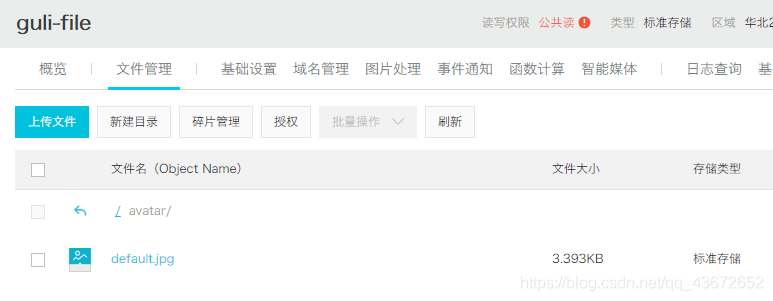一、对象存储OSS
为了解决海量数据存储与弹性扩容(主要是静态文件的存储例如图片,语音,视频等),项目中我们通常采用云存储的解决方案- 阿里云OSS。
1、开通“对象存储OSS”服务
(1)申请阿里云账号
(2)实名认证
(3)开通“对象存储OSS”服务
(4)进入管理控制台
2、创建Bucket
选择:标准存储、公共读、不开通

3、上传默认头像
创建文件夹avatar,上传默认的用户头像

4、创建RAM子用户


添加用户


输入手机号验证码
设置用户权限
这里点击添加权限,使用的是OSS和VOD所以选择对象云存储和阿里云视频点播管理功能的权限。

获取子用户AccessKeyId,AccessKeySecret

使用Java SDK

1、创建Maven项目
com.test.aliyun-oss
2、pom
<dependencies>
<!--aliyunOSS-->
<dependency>
<groupId>com.aliyun.oss</groupId>
<artifactId>aliyun-sdk-oss</artifactId>
<version>2.8.3</version>
</dependency>
<dependency>
<groupId>junit</groupId>
<artifactId>junit</artifactId>
<version>4.12</version>
</dependency>
</dependencies>
3、找到编码时需要用到的常量值
(1)endpoint
(2)bucketName
(3)accessKeyId
(4)accessKeySecret
4、测试创建Bucket的连接

public class OSSTest {
// Endpoint以杭州为例,其它Region请按实际情况填写。
String endpoint = "your endpoint";
// 阿里云主账号AccessKey拥有所有API的访问权限,风险很高。强烈建议您创建并使用RAM账号进行API访问或日常运维,请登录 https://ram.console.aliyun.com 创建RAM账号。
String accessKeyId = "your accessKeyId";
String accessKeySecret = "your accessKeySecret";
String bucketName = "guli-file";
@Test
public void testCreateBucket() {
// 创建OSSClient实例。
OSSClient ossClient = new OSSClient(endpoint, accessKeyId, accessKeySecret);
// 创建存储空间。
ossClient.createBucket(bucketName);
// 关闭OSSClient。
ossClient.shutdown();
}
}
配置文件application.properties
#服务端口
server.port=8001
#服务名
spring.application.name=xuexi-oss
#环境设置:dev、test、prod
spring.profiles.active=dev
#阿里云 OSS
#不同的服务器,地址不同
aliyun.oss.file.endpoint=your endpoint
aliyun.oss.file.keyid=your accessKeyId
aliyun.oss.file.keysecret=your accessKeySecret
#bucket可以在控制台创建,也可以使用java代码创建
aliyun.oss.file.bucketname=edu-service-test101
aliyun.oss.file.filehost=avatar
从配置文件中读取常量
创建常量读取工具类:ConstantPropertiesUtil.java
使用@Value读取application.properties里的配置内容
用spring的 InitializingBean 的 afterPropertiesSet 来初始化配置信息,这个方法将在所有的属性被初始化后调用。
/**
* 常量类,读取配置文件application.properties中的配置
*/
@Component
//@PropertySource("classpath:application.properties")
public class ConstantPropertiesUtil implements InitializingBean {
@Value("${aliyun.oss.file.endpoint}")
private String endpoint;
@Value("${aliyun.oss.file.keyid}")
private String keyId;
@Value("${aliyun.oss.file.keysecret}")
private String keySecret;
@Value("${aliyun.oss.file.filehost}")
private String fileHost;
@Value("${aliyun.oss.file.bucketname}")
private String bucketName;
public static String END_POINT;
public static String ACCESS_KEY_ID;
public static String ACCESS_KEY_SECRET;
public static String BUCKET_NAME;
public static String FILE_HOST ;
@Override
public void afterPropertiesSet() throws Exception {
END_POINT = endpoint;
ACCESS_KEY_ID = keyId;
ACCESS_KEY_SECRET = keySecret;
BUCKET_NAME = bucketName;
FILE_HOST = fileHost;
}
}
文件上传
public interface FileService {
/**
* 文件上传至阿里云
* @param file
* @return
*/
String upload(MultipartFile file);
}
SDK中:Java->上传文件->简单上传->流式上传->上传文件流
public class FileServiceImpl implements FileService {
@Override
public String upload(MultipartFile file) {
//获取阿里云存储相关常量
String endPoint = ConstantPropertiesUtil.END_POINT;
String accessKeyId = ConstantPropertiesUtil.ACCESS_KEY_ID;
String accessKeySecret = ConstantPropertiesUtil.ACCESS_KEY_SECRET;
String bucketName = ConstantPropertiesUtil.BUCKET_NAME;
String fileHost = ConstantPropertiesUtil.FILE_HOST;
String uploadUrl = null;
try {
//判断oss实例是否存在:如果不存在则创建,如果存在则获取
OSSClient ossClient = new OSSClient(endPoint, accessKeyId, accessKeySecret);
if (!ossClient.doesBucketExist(bucketName)) {
//创建bucket
ossClient.createBucket(bucketName);
//设置oss实例的访问权限:公共读
ossClient.setBucketAcl(bucketName, CannedAccessControlList.PublicRead);
}
//获取上传文件流
InputStream inputStream = file.getInputStream();
//构建日期路径:avatar/2019/02/26/文件名
String filePath = new DateTime().toString("yyyy/MM/dd");
//文件名:uuid.扩展名
String original = file.getOriginalFilename();
String fileName = UUID.randomUUID().toString();
String fileType = original.substring(original.lastIndexOf("."));
String newName = fileName + fileType;
String fileUrl = fileHost + "/" + filePath + "/" + newName;
//文件上传至阿里云
ossClient.putObject(bucketName, fileUrl, inputStream);
// 关闭OSSClient。
ossClient.shutdown();
//获取url地址
uploadUrl = "http://" + bucketName + "." + endPoint + "/" + fileUrl;
} catch (IOException e) {
throw new GuliException(ResultCodeEnum.FILE_UPLOAD_ERROR);
}
return uploadUrl;
}
}
controller
@Api(description="阿里云文件管理")
@CrossOrigin //跨域
@RestController
@RequestMapping("/admin/oss/file")
public class FileController {
@Autowired
private FileService fileService;
/**
* 文件上传
*
* @param file
*/
@ApiOperation(value = "文件上传")
@PostMapping("upload")
public R upload(
@ApiParam(name = "file", value = "文件", required = true)
@RequestParam("file") MultipartFile file) {
String uploadUrl = fileService.upload(file);
//返回r对象
return R.ok().message("文件上传成功").data("url", uploadUrl);
}
}
之后可以通过swaggerui进行接口测试,值阿里云控制台中查看文件是否上传成功!
以上有错误的地方尽情指出,一起学习进步!